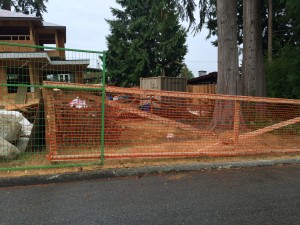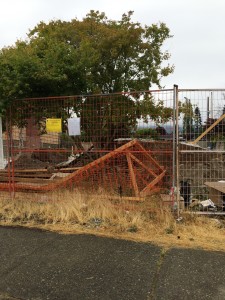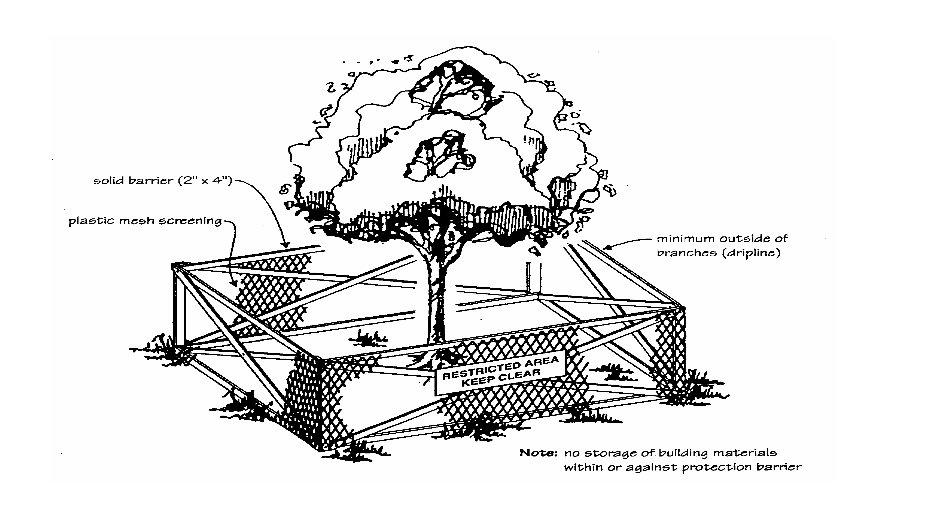There are three main risks associated with the demolition and site clearing phases of a construction project: the removal of vegetation and subsequent risk of soil erosion and sediment formation, the risk due to underground storage tanks, and the risk of chemicals present in the home being removed and demolished.
1. Vegetation Removal
During site clearing, the removal of trees and other vegetation takes place in order to prepare the site for excavation. A good place to begin to mitigate potential damage is by determining what vegetation can stay on site for as long of a time frame as possible. Vegetation prevents soil exposure, which in turn minimized erosion and the formation of sediment. Mitigation to reduce the impact of vegetation removal includes:
- Leaving as much vegetation onsite as possible for as long as possible to prevent erosion from taking place
- Leaving a buffer of vegetation around the perimeter of the site to allow for infiltration of water and to allow for any sediment created onsite to remain onsite and to stop sediment from entering into the storm water system
- Protecting trees with tree protection fencing for the duration of the project, ensuring that the fencing is maintained and not removed until final landscaping takes place
2. Underground Storage Tanks
Another potential risk to watersheds depends on whether or not underground storage tanks are present onsite and whether or not these tanks have been properly removed, tested and remediated to ensure that the surrounding soils have not been contaminated by the contents of these storage units. Typically, storage tanks held home heating fluids and as homes were updated to no longer required heating old to be stored in tanks underground or adjacent to the home, these tanks have were buried and pose a risk if they contain old heating or other fluids.
- Determine if underground storage tanks are present onsite
- If present, have a certified company remove and test the tank contents and surrounding soils
- If required, remove contaminated soils and dispose of them appropriately
3. Potential Chemical Contamination within demolished home
There are chemicals present in the homes being demolished that must be remediated prior to demolition. Leaking of chemicals and other potentially toxic substances from old homes present a risk to the surrounding environment and to people involved in the construction process if proper remediation work has not taken place prior to demolition. Examples of substances that pose a risk include: asbestos, lead, vermiculite and other insulation materials.
Asbestos was used in many different products in the home building industry, including but not limited to cement, floor and ceiling tile, insulation, drywall, pipe insulation and siding. Breathing in asbestos can cause many health issues such as mesothelioma and asbestosis.
- Hire a certified environmental remediation company to test the home for the presence of harmful chemicals and other substances
- Conduct remediation work to remove all identified substances and chemicals of concern using a certified remediation company
- Ensure that the remediation work has been done and that proper documentation is in place
- Safety of workers must be ensured during all remediation works






Great! This is a really good blog about the demolition, Keep up the good work!
~ Concrete Contractor Greenwood
facebook ~ facebook.com
Have you ever considered writing an ebook or guest authoring
on other blogs? I have a blog centered on the same topics
you discuss and would really like to have you share some stories/information. I know my visitors would value your work.
If you’re even remotely interested, feel free to send me an e mail.
My developer is trying to persuade me to move to .net
from PHP. I have always disliked the idea because of the costs.
But he’s tryiong none the less. I’ve been using Movable-type on a
variety of websites for about a year and am concerned about switching to another platform.
I have heard very good things about blogengine.net. Is there a way I can transfer all my wordpress content
into it? Any kind of help would be greatly appreciated!
First of all I want to say excellent blog! I had a quick question which I’d like to ask if you don’t mind.
I was interested to find out how you center yourself and clear your thoughts prior
to writing. I have had a difficult time clearing my thoughts in getting my thoughts out.
I truly do take pleasure in writing however it just seems like the first 10 to 15 minutes are wasted just
trying to figure out how to begin. Any recommendations or tips?
Cheers!
Mitigating the impacts of demolition, site clearing, and mobilization is crucial to minimize disruptions and environmental consequences during construction projects. Implementing effective mitigation measures ensures responsible and sustainable development practices.